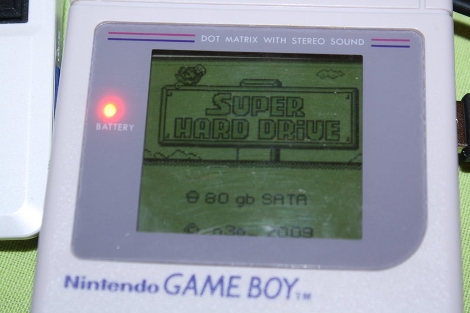[_n3o_] put together a nice external storage mod by fitting a 2.5″ drive into a broken Game Boy. This mod fooled quite a few people because it appears that the device still plays games with the drive stuffed inside of it. Sadly, this is not the case. The reflective backing has been removed from the screen and replaced by a piece of paper with a graphic printed on it. The LED from the hard drive was moved to the battery indicator for the Game Boy for added realism. There is no build log for this project but [_n3o_] did give a short explanation of it in a forum post. You can see two more pictures of the project after the break. Continue reading “80 Gig Drive Inside A Game Boy”
Month: September 2009
NES On ZipIt
[youtube=http://www.youtube.com/watch?v=uwxGQhtf4uU]
Going even further back in time than 4th gen, [Kevin] tipped us off to this project by [Hunter Davis]. It is a collection of software mods for Zipit’s Z2 instant messenging device. Some of them include allowing it to run (ports of) the Fluxbox window manager, FCE Ultra NES emulator, and (most impresively) the Java framework. The next leap in development, a SNES emulator optimized for the Zipit, is in the works. The Z2 runs Linux out of the box. This means you no longer have to reflash the device to add software, such as DOSbox (also introduced to the Zipit by [Hunter Davis]). Be sure to check out the video demo of FCE Ultra on the Z2 above.
Arduino Muon Detector

[Sebastian Tomczak] was borrowing a homeade muon detector from his friend, and managed to hook it up to his computer through an Arduino. The detector itself uses 3 fluorescent tubes to detect radiation. Three separate tubes are used in order to filter out terrestrial radiation; cosmic radiation will fall in-line with the tubes and pass through at least two of them, whereas terrestrial radiation will only hit one. There is some basic circuitry to amplify the signal and then perform the OR operation.
[Tomczak] used an Arduino to take the raw data and feed it into his computer. He then used Max/MSP to analyze the data and filter out background noise, leaving only the cosmic ray data. He didn’t mention what he was going to use the data for, though. Maybe he’ll hook it up to a synthesizer.
Related: Digital Geiger counter
[via @littlebirdceo]
700 Lumen LED Bike Lamp

We’ve seen bright bike lamps before. This one caught our eye because it needs a heat sink while in operation. [700lumenLED] built a super bright light for his bike that features an aluminum enclosure and heat sinks to protect the LEDs against overheating. Some nice work was done incorporating the 12v battery into a bike bottle with the power switch and a dimming potentiometer attached to the bottle cap.
Simple Pop-up Notifications

[Kristofer] shares a tip on a simple way to add pop-up notifications to Linux scripts. The package libnotify allows you to use the command “notify-send” to pop up a message when you need it. The syntax is simple enough, just place your message in quotes after the command like so:
notify-send "Go read hackaday.com"
There are a lot of other options that go along with this command such as adding an icon and setting how long the message will be displayed. This would be great for projects that interface through scripts, displaying messages as events happen. For Ubuntu, installing this package was as simple as “sudo apt-get install libnotify-bin”.
Top 10 IPhone Apps For Electronics Hackers

There are so many apps available for the iPhone, one might even say there are a plethora. We would like to take a moment to help you find a few that might help with your hacking projects. Ever have problems remember a formula when you need it? Need to track the acceleration of your brand new rover? How about beginners needing help remember resistor codes. Well, there’s an app for that. Check out our suggestions after the break.
Continue reading “Top 10 IPhone Apps For Electronics Hackers”
Look At Your Gerber Files With Gerbv

Tired of making kindergarten macaroni art PCBs? Check your Gerber files before you send them off to a fab house with a Gerber file viewer. Viewplot , GerbTool’s Viewer , and FAB 3000 Free DFM are all free versions of for-pay software to view your Gerber files. If you use Windows and demo software, these are nice options. If not, you can use gerbv. Allied with gEDA, Gerbv is free, open source software that you can use to view all of your RS-274X Gerber files and Excellon-type drill files. Still being worked on with an active development group, gerbv does not have all the bells and whistles, it does have the ability to delete objects. Check it out after the break. Continue reading “Look At Your Gerber Files With Gerbv”











